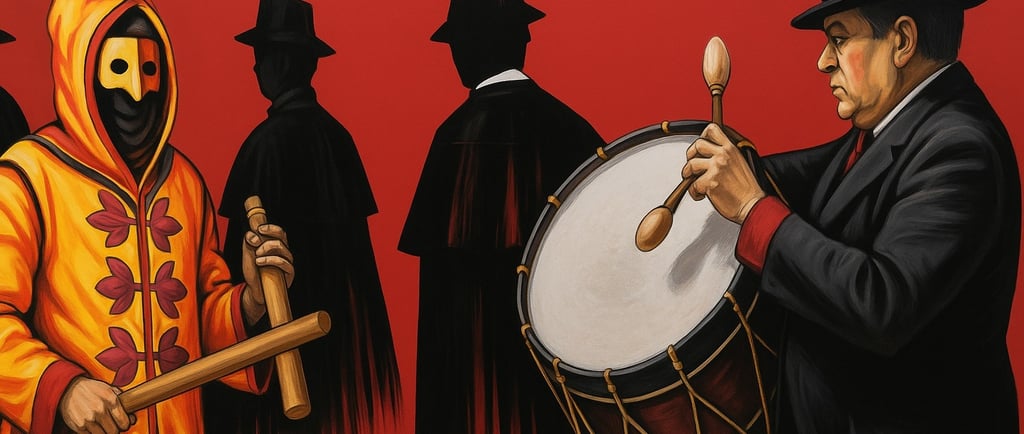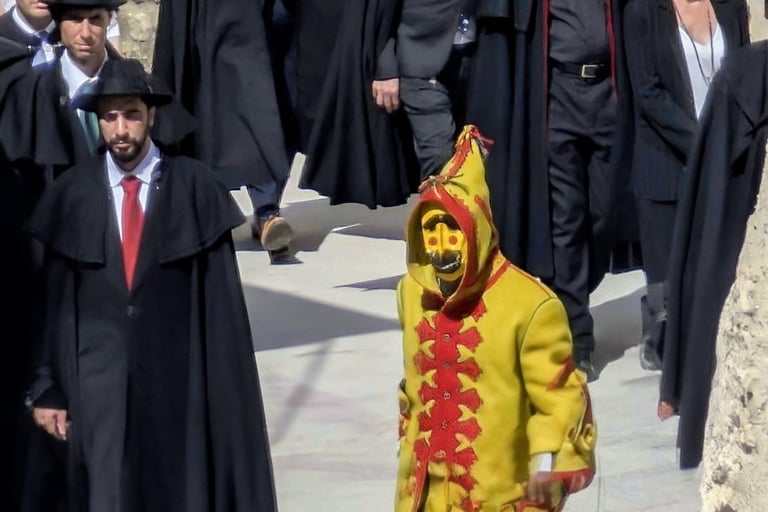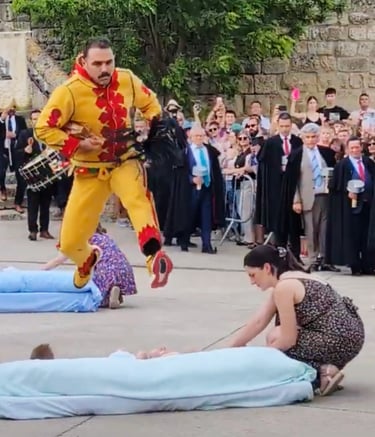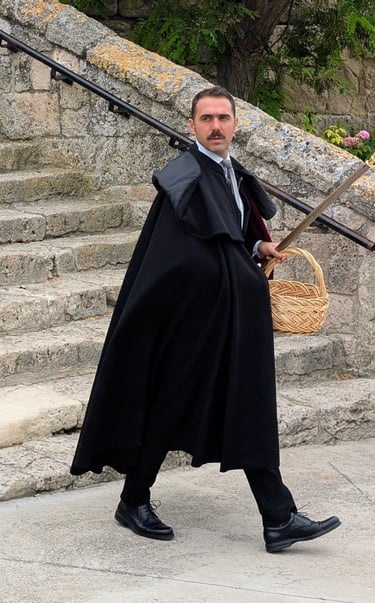El Colacho: Where Original Sin Meets Original Influence
Castrillo de Murcia hosts El Colacho, where the devil jumps over babies and mayhem meets Catholic ritual, with just enough Eucharist to keep it holy.
Hungry Culture
6/29/20254 min read


The Devil, the Eucharist, and the Atabalero: Inside El Colacho
Every year, newborn babies are taken to a tiny pueblo outside Burgos to have the devil incarnate jump over them. This is encouraged and even seen as a blessing by the Catholic Church. In a world obsessed with protecting the children, El Colacho laughs, leaping his way through centuries of chaos, proving tradition isn’t always tame.
To understand how this wild tradition came to be, we have to travel back to medieval times and unpack the Eucharist, the revered Crouton o’ Christ.


Castrillo de Murcia’s Corpus Christi Celebrations
El Colacho takes place in Castrillo de Murcia, a town built on centuries of conquest, reconquest, and religious spectacle in the province of Burgos.
The festival is held during Corpus Christi, about 60 days after Easter, and runs for six days. The main event, where the devil leapfrogs over unsuspecting infants, takes place on the Sunday after the feast.
But to understand how this bizarre tradition evolved, we need to look at Corpus Christi itself, a Catholic holiday established in 1264 to celebrate the Eucharist. The holy snackrament, for the Catholics insisted, and probably still do, that a crusty consecrated cracker is the literal body of Christ.
Back in medieval Europe, the devil wasn’t just lurking in hell; he was centre stage. Religious plays, parades, and pageants cast the devil as the villain in morality tales, bringing the eternal tug-of-war between good and evil to life. Fire, noise, dancing, and a flair for the dramatic were all part of the show.
So naturally, El Colacho would be a logical outcome. It’s a festival rooted in Corpus Christi’s celebration of holy presence, infused with medieval drama, symbolic upheaval, and a spectacle that still shocks us today.
El Cofradía: The Brotherhood
In 1621, El Cofradía o Hermandad del Santísimo Sacramento de Minerva (Brotherhood of the Blessed Sacrament) was founded in Castrillo de Murcia. Their job? Be brand ambassadors for the Jesus cracker. Make sure the Eucharist was adored by the masses, paraded through town, and positioned as the winning side in the battle against Protestantism.
As they were affiliated with the Santa Maria sopra Minerva of Rome, the brotherhood was entitled to throw the biggest bashes. These included dramatic religious theater, masked dancers, and processions led by a drummer (Atabalero), which led to the birth of El Colacho. Basically, they were the social influencers of the Middle Ages.
The night before El Colacho, Castrillo de Murcia transforms. Around 11 PM, the pueblo goes black. The lights shut off, and the Church of Santiago Apóstol, a Gothic and Renaissance structure from the 15th and 16th centuries, becomes a stage for a dramatic light show that blends sacred and demonic vibes.
Live music, traditional drums, and dancing take over the town. Masked “devils” run wild with sparklers, chasing anyone bold enough to get close. It’s part pagan, part holy, and completely chaotic. Eventually, the night ends with fireworks and fire on parade.

El Colacho, El Cofradía y El Atabalero
Jumping to Take the Sin Away


The final act, and climax of El Colacho, is when the Colachos (there are two, one in yellow and one in green) are symbolically forced to jump over the newborn babies to avoid tampering with their innocence.
Mattresses with pillows are laid throughout the village streets. Altars with flowers and wine are placed in front of the houses.
Families bring out their little ones, born in the last 12 months, and place them on the makeshift beds. Some go more peacefully than others.
Like in the earlier Vueltas, the Brotherhood, the Atabalero, and the Colachos make their way from the church to the street.
The Colachos, this time without their masks, begin their warm-up and prepare to leap. Girls from the village line the path in white dresses with colorful sashes. Their dance, rhythmic and repetitive, represents virtue and grace and sets the tone for cleansing.
The Colachos circle the area and leap over each set of mattresses, one after the other, with tarañuelas and zurriago in hand. A priest follows, blessing each baby and altar in a ritual that combines spiritual protection, symbolic cleansing, and, frankly, some serious bragging rights.
To date, no babies have been harmed.
El Colacho is equal parts history, madness, and sacred theatrics rolled into one. It’s a festival that has been raising hell for holy reasons throughout centuries. The question is, would you let the devil jump over your little one for divine sanction?
The Eve of Colacho: Chaos & Fire


On Sunday morning, the town bell rings the “toque de maitines” to call everyone to prayer. Calm and reverence last only a moment before the madness resumes.
El Colacho and the Atabalero begin their rounds, known as the corridas del Colacho or “Vueltas.” These are 15- to 20-minute ritual processions through the pueblo.
The Brotherhood leads the way. El Colacho follows, wearing a bright yellow suit with tassels and red zigzag stripes. His grotesque mask, the birria, features dark eyes, a large nose, and a twisted chin. He beats his tarañuelas and waves his zurriago, storming through the streets and stirring up chaos. At his side, the Atabalero keeps time on his atabal drum, announcing the presence of the Blessed Sacrament with every beat.
Together, they symbolize the eternal loop of chaos and order.
